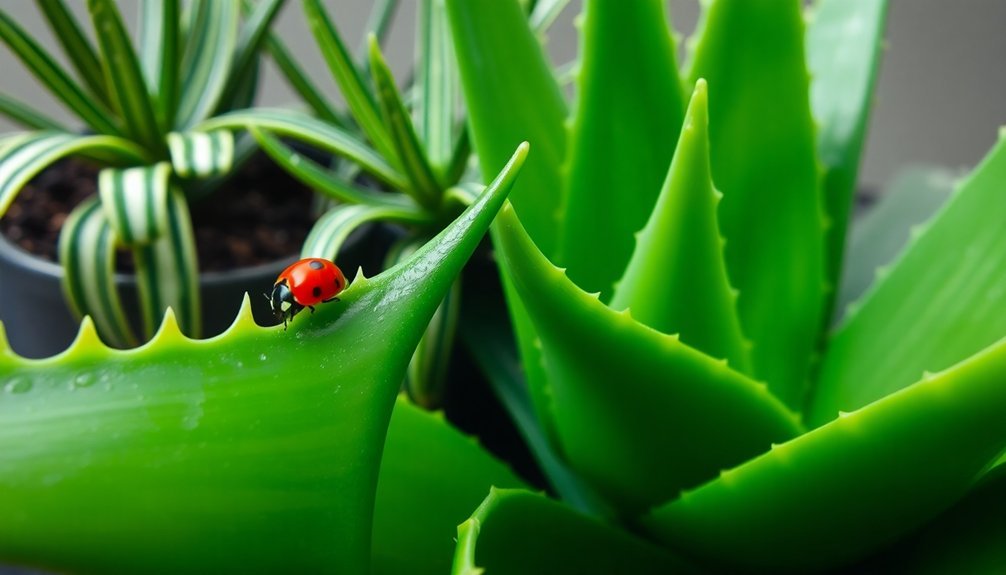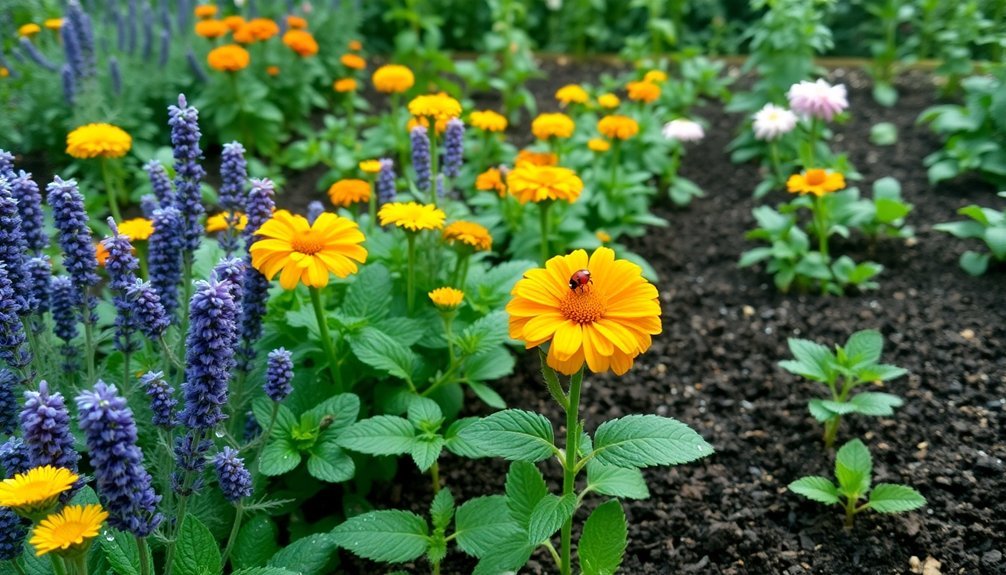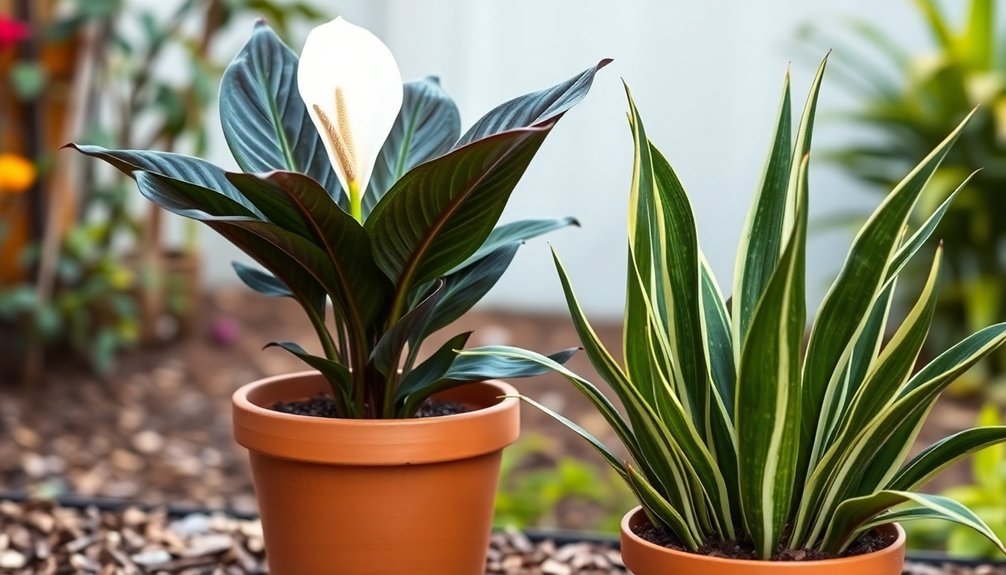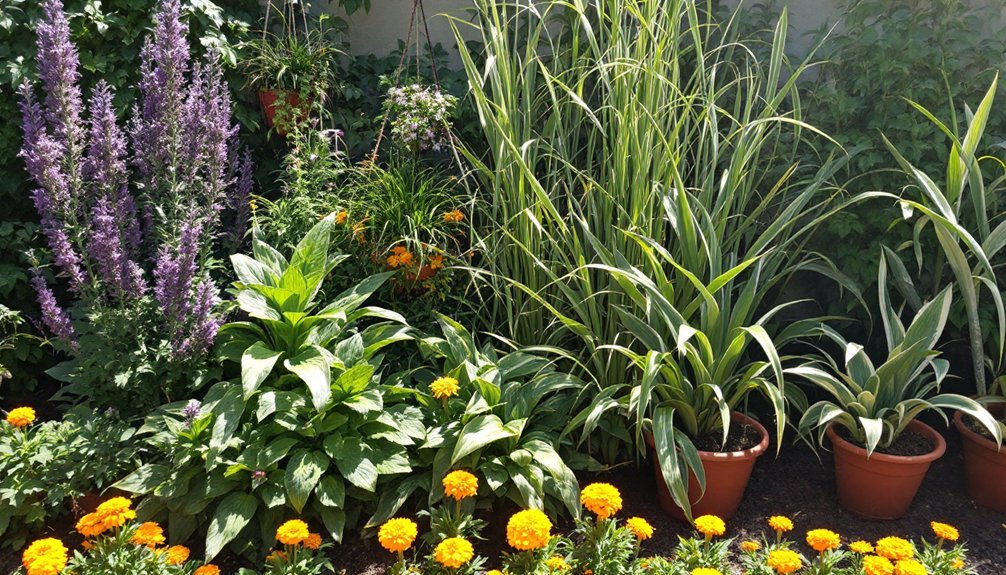Seven powerful plants can transform your home and garden's air quality while naturally repelling unwanted pests. You'll want to add Snake Plant and Peace Lily indoors for their formaldehyde-fighting abilities, while Spider Plant tackles carbon monoxide. In your garden, plant Marigolds, Lavender, Basil, and Rosemary to create a natural pest barrier. Strategic placement of these botanical defenders will maximize their pollution-fighting and pest-repelling potential, revealing their full protective powers.
Understanding Plant Defense Mechanisms

While gardeners often focus on providing water and nutrients, understanding how plants defend themselves is essential for maintaining a healthy garden. Nature has equipped plants with sophisticated defense mechanisms that not only protect them from pests but also help purify the air around them.
You'll find that plants produce powerful compounds like alkaloids and terpenes that serve multiple purposes. These natural chemicals ward off harmful insects while some can even filter air pollutants.
Physical defenses, such as thorns and tough leaves, provide protection against larger threats. Many plants, including marigolds and garlic, release natural compounds that repel unwanted pests.
Top Air-Purifying Indoor Plants
When it comes to improving indoor air quality, certain houseplants excel at filtering out common pollutants while requiring minimal care.
To combat indoor air pollution effectively, you'll want to take into account plants like the Snake Plant, which powerfully removes formaldehyde and benzene with little maintenance.
Snake Plants are powerful natural air purifiers, eliminating harmful formaldehyde and benzene while requiring minimal care and attention.
For spaces up to 200 square feet, you can't go wrong with a Spider Plant that tackles carbon monoxide.
If you're dealing with low-light areas, the Peace Lily is your best choice for filtering trichloroethylene.
While the Boston Fern is excellent at removing xylene and toluene, you'll need to maintain higher humidity for best results.
For beginners concerned about air quality, the Rubber Plant is an ideal choice – it's easy to grow, tolerates dim conditions, and effectively eliminates formaldehyde from your indoor environment.
Natural Pest-Repelling Garden Plants

Just as indoor plants can purify your air, outdoor garden plants can naturally defend your landscape against unwanted pests.
While you're improving indoor air with house plants, your garden can work as a natural shield against destructive insects.
Consider these powerful natural pest repellents for your outdoor space:
- Marigolds guard your garden by masking plant odors that attract nematodes and aphids.
- Lavender serves dual duty by repelling mosquitoes while attracting beneficial pollinators.
- Basil keeps flies at bay and enhances the flavor of neighboring vegetables.
- Peppermint and rosemary work together to deter various pests, from ants to cabbage moths.
These aromatic defenders not only protect your garden but also add beauty and fragrance to your outdoor sanctuary.
Signs of Plant Effectiveness Against Pollutants
Understanding your plants' effectiveness against pollutants doesn't require complex equipment or scientific testing. You'll notice your Best Plants are working when your indoor air feels fresher and cleaner within just a few days.
Spider Plants and Peace Lilies show their air filter capabilities through vibrant, healthy growth while tackling indoor pollutants.
Watch for signs like reduced allergies, better sleep quality, and improved overall well-being. If you've got a Snake Plant, you might notice better air quality even in the morning, thanks to its unique ability to produce oxygen overnight.
Boston Ferns display their effectiveness through lush, abundant fronds, while actively cleaning the air. Your plants' success is also evident in your own enhanced mood and reduced stress levels – a clear indicator they're doing their job effectively.
Maintenance Tips for Optimal Plant Performance

Now that you can recognize your plants' effectiveness, maintaining their peak performance requires consistent care and attention. Your indoor plants need specific maintenance routines to maximize their pollution-fighting capabilities and pest resistance.
Keep your indoor warriors fighting strong with dedicated care routines that maximize their natural abilities to combat pollutants.
- Monitor soil moisture regularly with a moisture stick for plants like Bamboo Palm, adjusting your watering schedule based on their needs.
- Maintain proper humidity levels by misting frequently and using a humidifier, especially for moisture-loving plants like Boston Fern.
- Keep leaves clean and healthy by pruning and dusting regularly, which enhances their air-purifying abilities.
- Support growth during active seasons with balanced fertilizer, and remember to rotate pots for even light exposure.
These essential maintenance practices won't just keep your plants alive – they'll guarantee your green allies continue fighting pollutants and pests effectively.
Plant Placement Strategies for Maximum Impact
Your plant placement choices can make all the difference between mediocre and outstanding results, whether you're working with indoor spaces or outdoor gardens.
You'll want to map out areas based on natural sunlight patterns and air circulation, ensuring that air-purifying plants receive indirect light while pest-repelling varieties get proper exposure along garden perimeters.
To maximize their collective impact, group plants with similar care requirements together, creating designated zones that combine complementary species like moisture-loving ferns with other humidity-enhancing varieties.
Interior Vs Exterior Zones
When planning your pollution-fighting garden strategy, the careful placement of plants in both interior and exterior zones can dramatically amplify their pest-control and air-purifying benefits.
Inside your home, position indoor plants like Spider Plant near windows to maximize their ability to filter air pollutants through enhanced photosynthesis.
For ideal results in both zones, consider these key placement strategies:
- Place Bamboo Palm near entryways to create natural pollution barriers.
- Install vertical living walls to maximize air filtration in limited spaces.
- Position air-purifying plants by windows for better photosynthesis efficiency.
- Plant aromatic herbs along exterior borders to repel pests naturally.
Don't forget to incorporate native plants in your outdoor spaces – they'll attract beneficial insects while creating a natural defense system against unwanted pests.
Sunlight and Air Flow
Building on effective plant placement zones, understanding sunlight exposure and airflow patterns can supercharge your plants' pollution-fighting abilities.
You'll want to position air-purifying champions like Snake Plant and Spider Plant where they'll receive indirect sunlight, maximizing their ability to filter pollutants without leaf damage.
Create strategic gaps between your plants to optimize air circulation, which helps control humidity and enhances their natural filtering capabilities.
Place taller varieties like Rubber Plant and Dracaena near windows, where they'll benefit from both natural light and increased airflow.
Don't forget to utilize darker corners with low-light specialists such as Peace Lily.
Strategic Grouping Methods
To maximize your plants' pollution-fighting and pest-deterrent powers, strategic grouping plays an essential role in their effectiveness.
When you use thoughtful plant arrangements, you'll create natural barriers against pests while enhancing your space's ability to filter pollutants like carbon dioxide.
Here are four key grouping strategies to implement:
- Position marigolds and nasturtiums around vulnerable crops to form natural pest barriers.
- Plant basil near tomatoes to improve growth and create mutual pest protection.
- Place air-purifying plants like snake plants in high-traffic areas for maximum impact.
- Create layered arrangements with tall sunflowers shading smaller plants, optimizing both space and light exposure.
This strategic approach not only protects your garden naturally but also maximizes each plant's potential to combat environmental pollutants and unwanted pests.
Combining Plants for Enhanced Protection
While single plants can offer pest protection, strategic plant combinations create a powerful natural defense system in your garden. When you use plants like marigolds alongside nasturtiums, you'll establish a natural barrier against common garden pests while attracting beneficial insects that help maintain balance.
Consider pairing tomatoes with basil to enhance their growth and ward off hornworms. You can protect your prized roses by planting garlic nearby, as its strong aroma naturally deters aphids.
To maximize your garden's defensive capabilities, incorporate flowering plants like lavender and borage, which attract pollinators that double as pest controllers. The key is creating diverse plant communities that work together – some plants will repel unwanted visitors while others lure pests away from your vulnerable garden plants.
Frequently Asked Questions
What Plant Absorbs the Most Pollution?
You'll find Snake Plants are the most effective pollution absorbers, as they're exceptional at removing formaldehyde and benzene from your air. They're especially powerful when placed in enclosed spaces like bedrooms or offices.
Which Plants Are Most Resistant to Pests?
You'll find marigolds, lavender, rosemary, nasturtiums, and mint are highly pest-resistant plants. They naturally repel common garden pests through their strong scents and chemical compounds, making them excellent choices for your garden.
What Plant Helps With Pollution?
You'll find Snake Plants and Peace Lilies are top air purifiers. Spider Plants remove up to 90% of toxins, while Rubber Plants tackle formaldehyde effectively. Boston Ferns filter out multiple pollutants.
What Plant Removes 78% of Airborne Mold?
The Peace Lily removes 78% of airborne mold from your indoor air. You'll benefit from its powerful air-purifying abilities, but keep in mind it's toxic to pets, so place it carefully in your home.
In Summary
You'll find that strategically placing these seven pollution and pest-fighting plants throughout your home and garden creates a powerful natural defense system. Maintain them properly, watch for signs of effectiveness, and combine different species to maximize their impact. By understanding how these plants work and caring for them correctly, you're creating a healthier, cleaner environment while keeping unwanted pests at bay naturally.





Leave a Reply